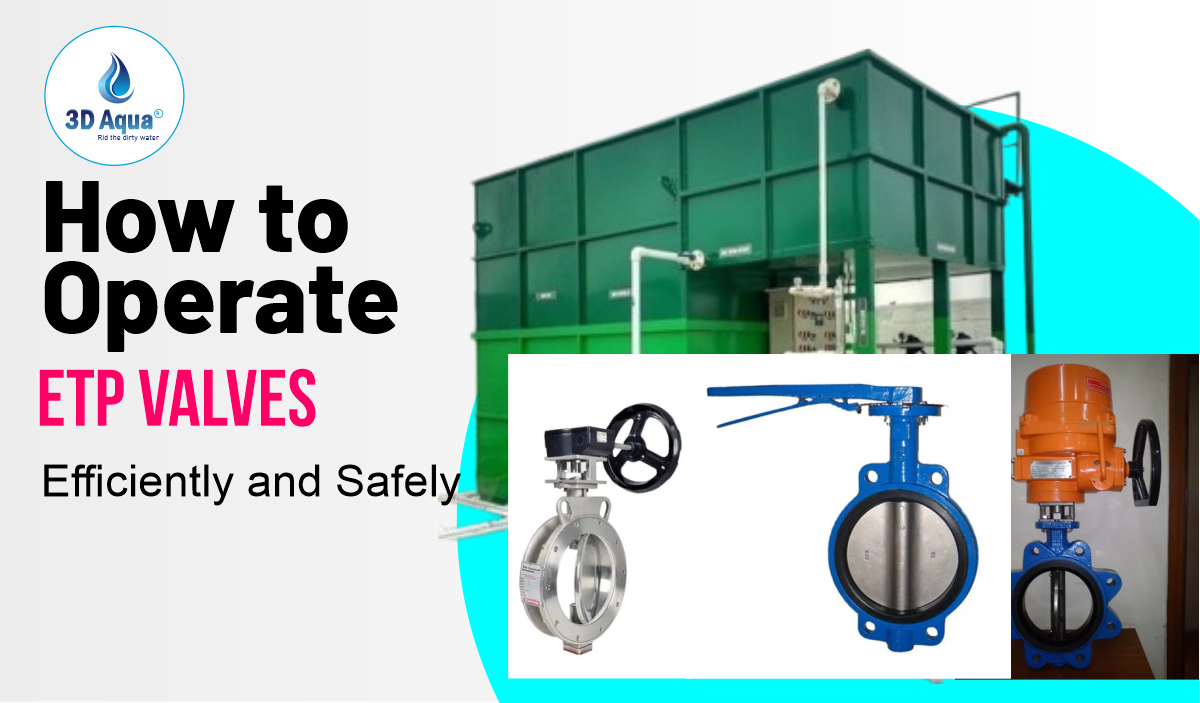Effluent Treatment Plants (ETPs) rely on a variety of valves to regulate the flow of wastewater, chemicals, and treated effluent. Proper operation of these valves is critical to ensuring plant efficiency, preventing leaks, and maintaining seamless wastewater treatment processes. Understanding the correct handling of these valves not only enhances plant performance but also prevents potential system failures and costly repairs.
Types of Valves Used in ETPs
Before learning the operational procedures, it is essential to understand the different types of valves utilized in an Effluent Treatment Plant. Each type serves a distinct purpose in controlling the flow of liquids and gases within the system.
- Gate Valves – Used for on/off flow control, these valves provide minimal resistance when fully open but should always be completely opened or closed to prevent damage.
- Ball Valves – Commonly used in chemical dosing lines, these valves offer tight closure and quick shut-off for precise control.
- Butterfly Valves – Suitable for regulating high-volume water flow with minimal pressure loss, often used in aeration and filtration processes.
- Globe Valves – Designed to regulate flow rates with controlled opening and closing, frequently used in sludge handling and aeration systems.
- Diaphragm Valves – Ideal for flow regulation in chemical and sludge lines, these valves ensure precision and prevent contamination.
- Check Valves – Essential for preventing backflow and maintaining unidirectional flow within pipelines.
- Pressure Relief Valves – Protect pumps and pipelines by releasing excess pressure when necessary, preventing potential damage and overloading.
Each valve serves a specific function, and its proper operation ensures precision in wastewater treatment and process control.
Operational Procedures for ETP Valves
1. Pre-Operation Condition Check
Before opening or adjusting any valve, conduct a thorough inspection for signs of leakage, corrosion, or mechanical defects. Ensure that the valve handle or actuator is functional and that there are no obstructions in the valve line that could affect performance.
2. Opening and Closing Valves
Different valves require specific handling techniques to ensure smooth operation:
- Gate Valves & Ball Valves – Rotate the handwheel or lever fully counterclockwise to open and clockwise to close. Partial opening can lead to turbulence and increased wear.
- Butterfly Valves – Operate using a 90-degree turn of the lever for quick opening and closing. Ensure the disc moves freely to avoid damage.
- Globe Valves – Adjust gradually by rotating the handwheel to control flow. Avoid excessive force, as this may harm internal components.
3. Adjusting Flow Rates
For valves used in flow regulation:
- Open slowly while monitoring pressure gauges and flow meters.
- Adjust gradually to reach the desired flow rate.
- Secure the valve in place, if needed, to prevent accidental changes.
4. Ensuring Proper Sealing
After closing a valve, inspect joints and packing for leaks. If leakage is detected, tighten the packing gland or replace the sealing components to maintain a secure closure.
5. Monitoring Valve Functionality During Operation
- Perform regular valve checks to ensure smooth operation and avoid applying excessive force when opening or closing.
- For motorized or automated valves, verify that actuators receive proper electrical or pneumatic signals.
- Keep records of maintenance activities, including adjustments and repairs, to monitor long-term performance trends.
Troubleshooting Common Valve Issues
Even with proper maintenance, valves may experience issues over time. Here are some common problems and solutions:
- Valve Leakage – Often caused by worn seals or incomplete closure. Tighten the packing gland or replace faulty seals.
- Difficult or Stiff Valve Operation – May indicate internal corrosion or sediment buildup. Clean and lubricate the valve mechanism to restore functionality.
- Incomplete Closure – Blockages in the valve seat may prevent full closure. Flush the valve or manually clean debris.
- Pressure Loss Across the Valve – Partial clogging or sediment accumulation can cause reduced flow efficiency. Inspect and clear any obstructions.
Safety Precautions for Handling ETP Valves
To prevent accidents and ensure safe operation, follow these precautions:
- Always wear protective gear, including gloves and safety goggles, especially when handling chemical dosing valves.
- Release internal pressure before opening a valve to prevent sudden fluid discharge.
- Avoid excessive force when operating manual valves to prevent breakage.
- Power off motorized or automated valves before conducting maintenance work.
- Clearly label critical valves to prevent accidental operation by untrained personnel.
Conclusion
Proper operation and maintenance of ETP valves play a vital role in ensuring smooth wastewater treatment, preventing leaks, maintaining pressure stability, and avoiding flow obstructions. By understanding the function of different valve types, following correct operating procedures, and implementing safety measures, plant operators can enhance efficiency and extend the lifespan of their equipment. Regular monitoring and timely maintenance reduce the risk of unexpected failures, keeping the entire treatment system running smoothly.
Need Expert Advice on Wastewater Treatment Solutions?
If you’re facing challenges in selecting the best water and wastewater treatment solutions, our team of experts at 3D Aqua is here to help. Whether you need assistance with ETP valve operation or comprehensive treatment plant management, we offer tailored solutions to meet your needs.
📞 Contact Us: 7011143366
📧 Email: info@3daqua.in
🌍 Visit: www.3daqua.in
Get in touch today for expert guidance and optimized wastewater treatment solutions!

